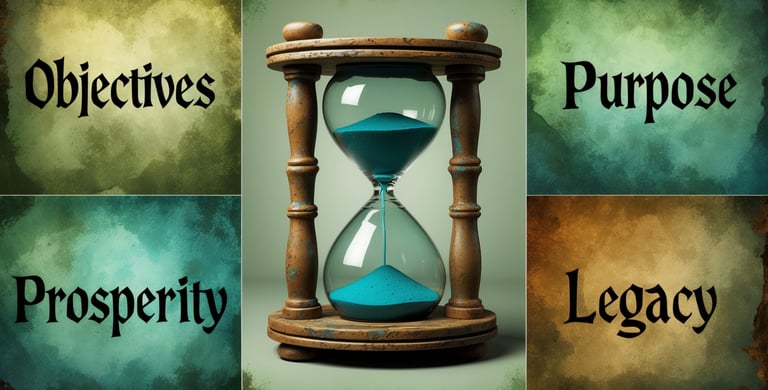Legacy Is Not Memory
The Transfer of Order from a Man Who Built with Fire
4FORTITUDEO - OBJECTIVES, PURPOSE, PROSPERITY, LEGACY
Legacy Is Not Memory
The Transfer of Order from a Man Who Built with Fire
“So teach us to number our days, that we may apply our hearts unto wisdom.”
— Psalm 90:12
Legacy Is Not About Being Remembered—It Is About Remaining Useful
Most men think legacy is about stories. Photos. Videos. Tributes. Monuments.
They believe they are remembered through admiration or nostalgia.
But memory fades. Stories change. Emotions distort.
True legacy is not what they feel about you. It’s what they do because of you.
Legacy is not sentiment—it is spiritual infrastructure. Moral architecture. Habits that do not die with the man who taught them.
It is not carved into stone. It is carved into structure:
Calendars
Rituals
Codes
Rhythms
Constraints
Decisions repeated long after the reason is forgotten
The man of legacy is not remembered. He is continued.
Memory Fades. Order Remains.
You do not build legacy by making an impression.
You build it by embedding your law into the walls of your house.
Sons forget advice. They remember rhythm.
Teams forget slogans. They remember standard.
A community forgets the man—but cannot escape the structure he built.
This is why Moses gave laws, not poems.
Why David prepared plans for the temple, not just encouragement.
Why Christ gave commands, covenants, and commissions—not just compassion.
The world doesn’t need more fathers of feeling. It needs fathers of form.
What a Man Must Transfer to Leave a True Legacy
You must pass on more than sentiment. You must pass on systematic order.
1. Moral Order
Your code of honor
Your convictions under pressure
Your family’s yes and no
Write it. Model it. Repeat it until it becomes subconscious in your lineage.
2. Temporal Order
How the day is governed
How time is structured
What rhythms remain no matter the season
If your death disrupts the household’s discipline, then your legacy was based on presence—not on system.
3. Financial and Territorial Order
How resources are managed
How land is kept
How giving is governed
Legacy without stewardship is not holy. It is fragile generosity.
4. Relational and Intergenerational Order
How fathers train sons
How sons honor fathers
How forgiveness and authority co-exist
A house without hierarchy becomes a household of orphans—even with two parents.
The Dangers of Sentimental Legacy
Many men try to build legacy through:
Inspiring quotes
Emotional apologies
Compelling life stories
Occasional expressions of love
These are valuable. But insufficient.
Sentiment must rest on structure—or it becomes a memory with no muscle.
If you do not transfer order, then:
They will cry at your funeral and forget your values
They will post your photo but break your patterns
They will inherit your house—but not your house’s holiness
How to Transfer Order Practically
Step 1: Build the Legacy Codex
A written, living document that includes:
Moral code
Daily schedule template
Family mission statement
Principles of wealth and work
Decision-making framework
Biblical or philosophical anchoring texts
Update it quarterly. Pass it down annually. Speak from it monthly.
Step 2: Embed Order Through Repetition
Weekly sabbath or household council
Monthly instruction or correction
Seasonal rite of passage rituals
Annual covenant renewal—spoken aloud
Let time itself bear the weight of your teaching.
Step 3: Create Legacy Tools
A journal of letters to your descendants
A digital archive of principles, failures, and victories
A family crest, motto, or creed etched visibly in the home
A strategic trust, business, or estate built for long-term alignment
If your presence disappears and the system collapses—you built a fanbase, not a fortress.
Counterperspectives and Righteous Response
Objection: But I just want to be remembered fondly.
Response: Then you are building for ego, not eternity. Your name is not the point. The order behind your name is.
Objection: This feels like too much structure.
Response: Then prepare for drift. Your descendants will follow whatever pattern is strongest—either yours, or the world’s.
Objection: What if my children resist it?
Response: They cannot inherit what you do not build. Their response is not your responsibility. But your structure is.
Wisdom and Warning
If you leave only memory:
You will be remembered with fondness, but not followed
Your name will fade into story, not structure
Your sons will build again from scratch—if they build at all
If you transfer order:
Your house will hold its shape
Your words will be repeated like law
Your death will not end your influence—it will deploy it
A man of legacy does not leave behind fans. He leaves behind builders.
Final Charge
You were not called to live a good life.
You were called to build a pattern of order so sacred that it continues in your absence.
Let your children inherit more than assets. Let them inherit time structure, moral gravity, and strategic clarity.
Carve it in writing. Embed it in rhythm. Embed it in their instincts.
And when you are gone—let them walk the roads you paved without confusion.
Irreducible Sentence
Legacy is not being remembered—it is building something so ordered they do not forget how to live when you are gone.


